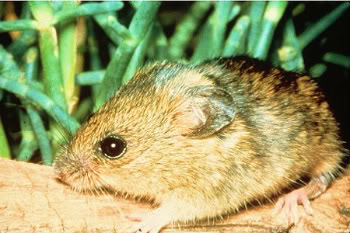In a January op-ed in Science, ecologist Jaboury Ghazoul wistfully and wittily ponders how far the 789 billion stimulus bill recently passed by the US Congress could go toward saving our planet’s embattled life-forms.
In his essay, Ghazoul suggests we put the 700 billion “in the context of the species extinction crisis”.
According to various scientific analyses the extinction rate is currently 100 to 1,000 times the average. Such a catastrophic loss of species—while making the world a lonelier and less interesting place—will unpredictably reshape ecosystems we depend on, causing social, political, and economic upheaval.
 The endangered salt marsh harvest mouse. Photo by Paul Kelly. Courtesy of the EPA. |
Ghazoul writes that if we estimate the number of species on earth as 10 million then “to ward against extinction, we could equitably award $70,000 to each and every one of these 10 million species from our $700 billion cash injection.”
As an ecologist who has worked largely with plants and insects, Ghazoul describes how such species may benefit from their share of the stimulus: “In Borneo, the 350 or so species of dipterocarp trees could form a union to demand existence rights, using their $25 million to lobby for viable landscape mosaics in which they could persist alongside competing land uses…The 43 species of ants from E. O. Wilson’s single leguminous tree at the Tambopata Reserve in Peru could pool their resources to buy about 150,000 hectares of Amazonian forest (at $20 per hectare)…Even copepods, those diminutive denizens of the deep, would receive just short of $1 billion, yet their ubiquity will ensure that they would have little need of such financial security.”
Of course not every species is threatened with extinction. For those currently safe, Ghazoul imagines a grand savings plan. “The roughly 7.5 million species not considered at risk could bank their collective $525 billion, hedging their bets against some future need. The interest thereby generated could subsidize species with greater financial and conservation needs and, if reinvested, could maintain the capital stock.”
Perhaps ironically, one of the spending programs that pundits have jumped on from an early version of the stimulus package was a proposal for conserving wetlands in California that would aid the salt marsh mouse, an endangered species that has lost 85 percent of its habitat. Critics were dismayed that the species—and the wetlands that sustain them—were to receive 30 million dollars under the stimulus.
But, though this item is continually brought up by critics, there is no money in the stimulus for California wetlands or the salt marsh mouse. However, perhaps, that’s beside the point. The anger at this false tale shows how little people still value ecosystems—like wetlands—which provide clean water for consumption, places for fishing and recreation, and, yes, habitats for species on the edge of extinction.
What then would be so bad if California’s wetlands received 30 million dollars—and one species, at least, could be saved? Ghazoul’s essay, while tongue-in-cheek, is serious both about the plight of species worldwide and the fact that the global environmental crisis is continuing to be ignored.
“But where would $700 billion come from?” Ghazoul ponders regarding his hopeful version of the package. “From borrowing, of course. We have been borrowing from Nature’s capital for nigh on the last few centuries—is it not time we paid some back?”
Related articles
One quarter to one third of mammals threatened with extinction
(10/06/2008)
One in four of the world’s land mammal species and one in three marine mammal species is threatened with extinction, according to an update of the IUCN Red List, the gold standard for the conservation status of global biodiversity.
7 steps to solve the global biodiversity crisis
(08/11/2008)
Many biologists believe Earth is entering a sixth mass extinction event, one that has is the direct of human activities, including over-exploitation, habitat destruction and introduction of alien species and pathogens. Climate change — largely driven by anthropogenic forces — is expected to soon increase pressure on Earth’s biodiversity. With population and per-capita consumption expected to grow significantly by the mid 21st century, there seems little hope that species loss can be slowed. Nevertheless, writing in the journal PNAS, Stanford biologists Paul R. Ehrlich and Robert M. Pringle suggest seven steps to help improve the outlook for the multitude of species that share our planet.
48% of primates threatened with extinction
(08/05/2008)
48 percent of the world’s primate species are at risk of extinction, according to the first comprehensive review of the world’s primates since 2003. The results were released as an update to the IUCN Red List at the 22nd International Primatological Society Congress in Edinburgh, Scotland.
16,306 species threatened with extinction
(09/12/2007)
16,306 of 41,415 species on the IUCN Red List are threatened with extinction, reports the World Conservation Union (IUCN). The total number of known extinct species now stands at 785, while a further 65 are only found in captivity or in cultivation. One in four mammals, one in eight birds, one third of all amphibians and 70% of the world’s assessed plants on the 2007 IUCN Red List are considered at risk.













